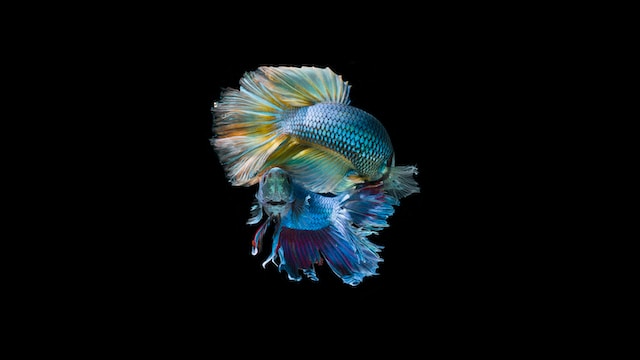Table of Contents
If you’re a betta fish enthusiast, you may have noticed that your fish’s color seems to change over time. This can be a cause for concern or excitement, depending on the situation. So, do betta fish change color? The answer is yes, they can!
Betta fish are a prevalent option for aquariums due to their vivid and striking colors, but their colors are not immutable. Betta fish can change color for a variety of reasons, including stress, illness, age, and even their environment. For example, if a betta fish is stressed or sick, it may lose its color or become dull. On the other hand, if a betta fish is happy and healthy, it may become more vibrant and colorful.
It is crucial to acknowledge that not all betta fish will alter their color. Certain betta fish have a genetic composition that maintains their colors unchanging throughout their lifespan. Nevertheless, if you do observe a change in your betta fish’s color, it is essential to monitor their conduct and health to ensure that they are not encountering any underlying problems.
Betta Fish Coloration
Betta fish are known for their vibrant colors, which can range from bright reds and blues to yellows and whites. However, it is important to note that not all betta fish will have the same coloration.
Betta fish can change color over time, but it is not a sudden or drastic change. Instead, it is a gradual process that can be influenced by a variety of factors such as age, stress levels, and environment.
Some betta fish may lose color as they age, while others may become more vibrant. In some cases, betta fish may even change colors completely. For example, a red betta may become a blue betta over time.
Stress can also cause betta fish to lose color. If a betta fish is kept in a small or overcrowded tank, it may lose color due to stress. Similarly, if the water quality is poor or the temperature is too low, a betta fish may lose color.
It is important to note that albino betta fish are an exception to the rule. Albino bettas lack the pigments that give other betta fish their vibrant colors, so they will always be white or pale in color.
Genetics and Color Change
Betta fish can change color due to genetics. The genes that determine the color of a betta fish are complex and can be influenced by several factors. One of the most common genetic factors that affect the color of betta fish is the “marble” gene.
Marble bettas, also known as marbled bettas, have a unique color pattern that can change over time. This color pattern is caused by a jumping gene that can randomly switch on and off, resulting in a marbled appearance. The marble gene can be present in both males and females and can be passed down to their offspring.
The color change in marble bettas can be triggered by several factors, including puberty, sexual maturity, and growth. As the betta fish matures, its color pattern may change, sometimes becoming more pronounced or more muted. This change in color is a natural process and is not a cause for concern.
Other betta fish may also change color as they mature. For example, some bettas may develop brighter colors as they reach sexual maturity, while others may become darker or more subdued. These changes in color are also a natural part of the betta fish’s growth and development.
Environmental Factors Affecting Color
The environment in which your betta fish lives can have a significant impact on its color. Here are some of the environmental factors that can affect the color of your betta fish:
Water Temperature: Betta fish are tropical fish and prefer water temperatures between 76 and 82 degrees Fahrenheit. If the water temperature is too cold or too hot, it can cause stress to the fish, which can lead to a loss of color.
Lighting: Lighting can also affect the color of your betta fish. If the tank is too brightly lit, it can cause the fish to become stressed, which can lead to a loss of color. On the other hand, if the tank is too dimly lit, it can cause the fish to become dull in color.
Tank Size: The size of the tank can also have an impact on the color of your betta fish. If the tank is too small, it can cause stress to the fish, which can lead to a loss of color. A larger tank can provide more space for the fish to swim and explore, which can help to keep them healthy and vibrant in color.
Plants: Adding live plants to your betta fish tank can help to improve water quality and provide a more natural environment for your fish. However, some plants can release toxins into the water, which can cause stress to the fish and lead to a loss of color.
Water Changes: Regular water changes are essential for maintaining good water quality in your betta fish tank. If the water quality is poor, it can lead to stress and a loss of color in your fish. Aim to change 25% of the water in your tank every week to keep your fish healthy and vibrant in color.
Water Parameters: It’s important to monitor the water parameters in your betta fish tank, including ammonia, nitrate, and nitrite levels. High levels of these substances can be toxic to your fish and cause stress, which can lead to a loss of color.
Diet and Color Change
The diet of your betta fish plays a significant role in its coloration. In the wild, bettas feed on a carnivorous diet that includes insects, larvae, and small crustaceans. In captivity, it’s essential to provide them with a nutritious diet that replicates their natural food sources.
A lack of nutrients, particularly vitamins and proteins, can lead to a loss of color in your betta fish. If your fish is not getting enough of these essential nutrients, it may become pale and lose its vibrancy.
One way to ensure your betta fish is getting the necessary nutrients is by feeding them a varied diet. You can offer them betta food, but it’s also a good idea to supplement their diet with live or frozen food, such as daphnia.
It’s important to note that overfeeding your betta fish can lead to health problems and a loss of color. While it’s tempting to give your fish as much food as it wants, it’s essential to monitor its appetite and feed it appropriately.
Health Issues and Color Change
Betta fish can change color due to various health issues. If your betta fish is showing signs of color change, it is essential to identify the underlying cause and take appropriate action. Here are some health problems that may cause color change in betta fish:
- Stress: Stress is a common cause of color change in betta fish. When betta fish are stressed, they may become pale or develop stress stripes. Stress can be caused by various factors, such as overcrowding, poor water quality, or sudden changes in water temperature.
- Illness and Disease: Betta fish can develop various illnesses and diseases that can cause color change. For instance, Ich, also known as white spot disease, is a common parasitic infection that can cause betta fish to develop white spots on their body. Columnaris is another bacterial infection that can cause betta fish to turn white or develop lesions.
- Fungi: Fungal infections can also cause color change in betta fish. Fungi can cause betta fish to develop white patches on their body or fins.
- Injury: Betta fish can get injured due to various reasons, such as fighting with other fish or getting caught in decorations. Injuries can cause betta fish to develop lesions or turn white.
If you notice any color changes in your betta fish, it is essential to take them to a veterinarian who specializes in fish health. The veterinarian can diagnose the underlying cause and provide appropriate treatment. In some cases, early treatment can save your betta fish’s life.
Tank Mates and Betta Fish Color
When it comes to the topic of whether betta fish change color, one factor that can play a role is the presence of tank mates. Betta fish are known for their vibrant colors, but certain tank mates can cause stress or aggression in bettas, which can lead to a dulling or fading of their coloration.
Some tank mates that are generally considered compatible with betta fish include:
- Snails
- Shrimp
- Corydoras catfish
- Neon tetras
However, it is important to note that not all bettas will get along with all tank mates. It is best to research the specific temperament and behavior of each species before introducing them to your betta’s tank.
Additionally, it is important to provide plenty of hiding places and visual barriers in the tank to help reduce stress and aggression between tank mates. This can include plants, rocks, and decorations.
Maintaining Betta Fish Color
Maintaining the vibrant colors of your betta fish requires proper care and attention. Betta fish have pigments in their scales that can fade or change color due to stress, illness, or poor water conditions. To keep your betta fish looking their best, here are a few tips to follow:
- Maintain clean water: Betta fish are sensitive to water conditions and require clean, filtered water to thrive. A dirty or unfiltered tank can lead to stress and illness, which can cause their colors to fade. Make sure to change the water regularly and keep the tank clean.
- Boost their diet: A balanced diet can help enhance the colors of your betta fish. Feeding them high-quality food with color-enhancing ingredients can help bring out their natural pigments. Look for fish food that contains carotenoids, which can help boost their red and orange colors.
- Keep the water temperature stable: Betta fish are tropical fish and require warm water to maintain their health and color. Use a heater to keep the water temperature between 76-82°F (24-28°C). Fluctuations in temperature can stress out your betta fish and cause their colors to fade.
- Monitor for signs of illness: Illness can cause betta fish to lose their color or develop abnormal color patterns. Keep an eye out for signs of illness such as lethargy, loss of appetite, or abnormal behavior. If you notice any of these signs, consult with a veterinarian or aquatic specialist.
By following these tips, you can help maintain the vibrant colors of your betta fish. Remember to keep their water clean, feed them a balanced diet, and monitor their health regularly.
Final Words
In conclusion, Betta fish are a popular pet among enthusiasts and breeders alike. While some Betta fish may change color over time due to environmental factors such as stress or illness, it is not a guaranteed occurrence. Additionally, it is important to note that Betta fish should not be kept in a small fishbowl as they require adequate space and filtration to thrive.
If you are considering adding a Betta fish to your collection, it is important to do your research and provide proper care to ensure their health and longevity. This includes providing a suitable tank with plenty of hiding places and plants, maintaining a proper water temperature and pH level, and feeding them a well-balanced diet.
While Betta fish may be known for their vibrant colors, it is important to remember that not all Betta fish will have the same coloration. Some Betta fish may have a more muted coloration, while others may have more vibrant colors. Additionally, certain Betta fish breeds, such as the Salmon Betta, may have unique coloration due to their genetics.
Overall, Betta fish are a fascinating and beautiful species that can make great pets when provided with proper care. Whether you are a seasoned Betta fish enthusiast or a first-time owner, it is important to always prioritize the health and well-being of your fish.







